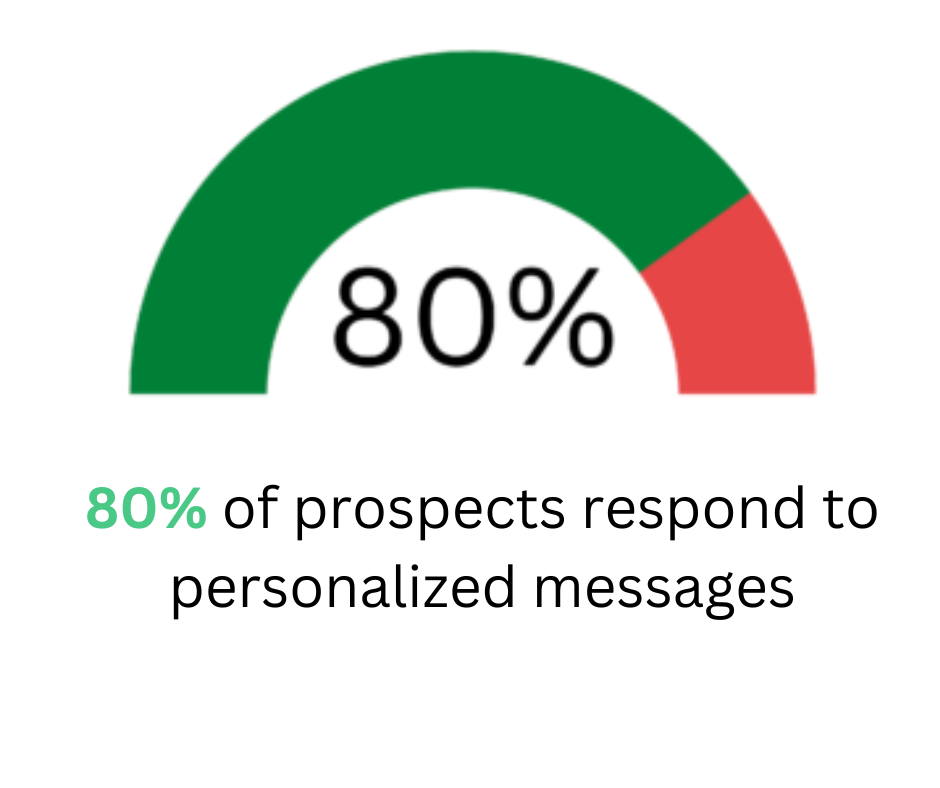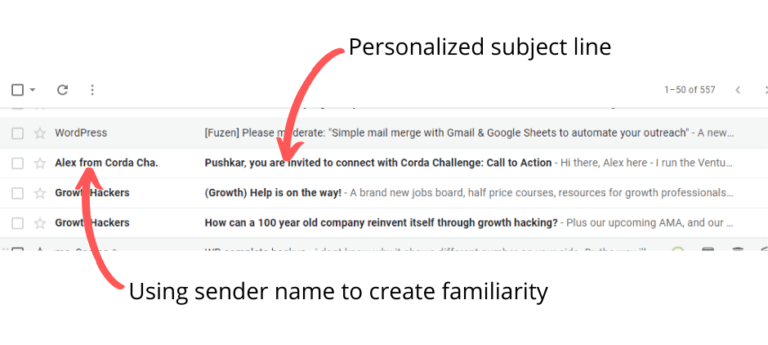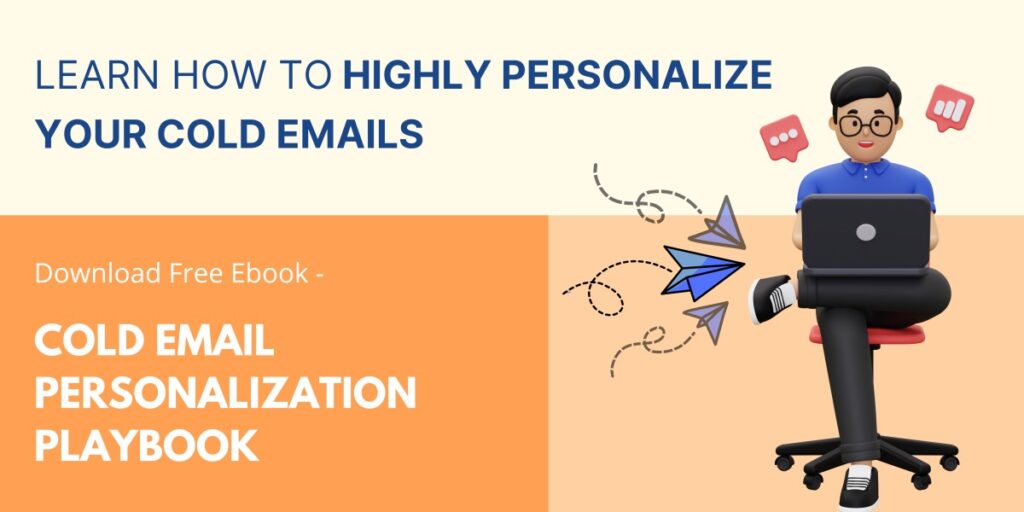Have you ever opened an email that says “New Product Launch: Check It Out!”. I have never.
Instead, I love exploring what’s more inside when I read my name in the subject line or if there is something of my interest.
This tells us how impactful personalization is when it comes to response rates.
Even a statistic from Hunter.io shows that a whopping 80% of prospects are more likely to respond to a company that send tailored messages.

So, if you want to get a positive response to your cold emails, you need to craft highly personalized, concise and valuable emails.
In this post, we have enlisted 8 effective email personalization examples to boost your response rate with personalization. Let’s explore them.
Effective ways to boost response rate with personalization
There are multiple ways to personalize your emails, we have highlighted the most effective email personalization examples.
1. Use Your Customers’ First Names
It may sound incredibly straightforward: just use your customers’ first names to encourage their response. Surprisingly, this simple tactic is highly effective.
When you start an email with a warm “Hello [FirstName],” it instantly grabs attention and creates a sense of familiarity.
It shows that you see your customers as individuals, not just another faceless name in your database.
Note: Remember, people love hearing their own names—it’s music to their ears! So, don’t underestimate the power of using just a first name.
Go ahead and sprinkle those first names throughout your emails to create a personal connection that resonates with your recipients.
2. Use a Descriptive and Intriguing Subject Line
Subject lines hold immense importance. So much so that 47% of prospects open or ignore an email based on the subject line.
Hence, crafting attention-grabbing personalized subject lines is crucial for the success and deliverability of your email campaigns.
Make your prospects think, “What’s this all about? I need to know!” Craft a subject line that pulls people in, enticing them to click and explore further.
3. Personalize the “From” Field as well as the “To” Field
When it comes to personalization, it’s not just about addressing your customers—it’s about presenting your brand in a way that feels familiar and trustworthy.
Hence, also focus on customizing the “From” field to display a recognizable sender name, such as your company name or a familiar team member.
This adds a personal touch and ensures your email doesn’t get lost among a sea of generic senders.
Additionally, personalize the “To” field by using the recipient’s name or a relevant identifier.

This small but meaningful detail shows that you value their individuality and sets the stage for a more personalized email experience.
4. Put Something in Your Customer’s Hands
In a digital world, there’s something special about receiving a physical item that captures your attention and leaves a lasting impression.
Consider including tangible elements in your emails, such as discount codes, exclusive offers, or even free samples.
When customers get something, it triggers a sense of excitement and engagement. It’s like receiving a gift—something they can physically interact with.
This simple act not only increases response rates but also enhances the overall brand experience, making your customers feel valued and appreciated.
5. Include Prospect-Specific Content
Personalization goes beyond addressing customers by name; it’s about tailoring your content to their specific needs and interests.
Segment your email list based on demographics, preferences, or purchase history. This allows you to create targeted content that speaks directly to each segment, addressing their pain points and offering relevant solutions.
By understanding your prospects’ unique challenges and desires, you can deliver a personalized experience that resonates deeply and compels them to take action.
6. Use Dynamic Content
Dynamic content is like a captivating element that brings your emails to life. It allows you to display personalized information within your email, adapting to each recipient’s preferences, location, or past interactions.
Imagine showcasing product recommendations based on their browsing history or tailoring the content to match their geographic location.
With dynamic content, your emails become more engaging, relevant, and, most importantly, highly personalized. It’s like giving your audience a front-row seat to a customized experience they won’t soon forget.
7. Incorporate Knowledge of Customer Conversions Into Personalization Efforts
When customers take action on a website, like buying something or filling out a form, and keep coming back for more, you gather lots of useful information.
This data can be used to create personalized marketing campaigns.
For example, you can suggest related products they might like based on their previous purchases (“You might also like…”).
You can also send them emails when the prices drop on items they’ve bought before or mail them coupons for things they buy frequently.
These tactics make customers feel special and connected to your brand, which is the magic of personalized marketing.
8. Leverage Rewards to Bring Customers Back
Do you offer a rewards program? No, you don’t need to be a huge company with many stores to use this effective method to foster customer loyalty.
When you digitally track reward points, you can send personalized reminders (“Just 10 more points, and you’ll get a free pastry!”) or give a free birthday/festival gift to show customers that you care about them. It’s a fantastic way to build strong connections with your customers and keep them coming back for more.

Conclusion
Personalization is the key to unlocking the full potential of your email campaigns. By incorporating effective email personalization examples, you can establish a genuine connection with your audience.
Remember, the goal is to create personalized experiences that resonate with your customers, foster trust, and ultimately drive meaningful results.
So go ahead, embrace the power of personalization, and watch your email response rates soar!
TL;DR
Boosting the response rate of your cold emails is crucial for successful outreach. To achieve this, focus on these email personalization examples.
- Use your prospects by their first names, craft attention-grabbing subject lines, and customize the “From” and “To” fields.
- Offer tangible items like discounts or free samples to engage customers.
- Tailor content based on their preferences and use dynamic elements for a captivating experience.
- Utilize customer conversion data to suggest relevant products and leverage rewards to foster loyalty.
These techniques create a personal connection, enhance engagement, and make your recipients feel valued. By incorporating personalization, you’ll see your cold email response rates soar, leading to better outcomes and stronger customer relationships.

Leave a Reply